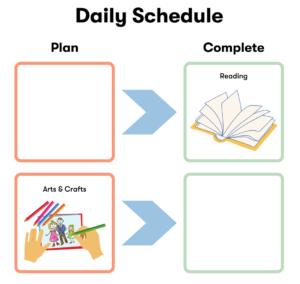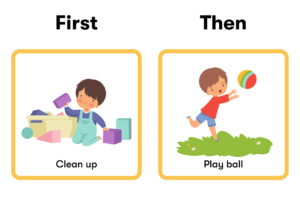Toddler tantrums can be a very difficult behavior to navigate with your kids, especially so with children on the spectrum. You might be asking yourself, “should my child be having tantrums at this age?”, “how long should their tantrums last?”, or “is it typical for tantrums to be occurring every day?”.
Most often toddler tantrums occur because your child does not yet have the communication skills to express their wants and needs. Tantrums are a normal part of child development and typically occur between the ages of 1-3 ½ years. After this age, toddler tantrums should start to decrease significantly in frequency and duration (Mayo Clinic, 2022).
As a parent of a toddler or child with autism, tantrums are likely to occur for longer time periods while your child is developing language or learning a communication system to be able to express their wants and needs.
Strategies for Reducing Toddler Tantrums
Part of our mission at MeBe is to educate parents and caregivers on evidence-based strategies for you to try at home. Below is a list of strategies you might try in an effort to prevent your child’s tantrums from occurring while their communication skills are growing (Bearss, 2018).
1. Provide choices
Choices are a great way to allow your child to have some independence while working within the options that you currently have available for them. If your toddler tantrums every time you tell them what they are going to eat for breakfast, try giving two options that you would be okay with them choosing – “would you like yogurt or cereal?”
Providing choices will allow your child to feel like they were able to make the decision of what to eat, which should reduce the likelihood of a tantrum. If you have a toddler or a child that does not have verbal language, show them the two physical options, or present them with two pictures to select from instead!
2. Use timers, visuals, or verbal warnings to signal transitions or schedule changes
Unlike adults, toddlers and children have no way to track their daily schedules or know when they have upcoming events. By utilizing timers or visual/verbal warnings for those upcoming events, you can help reduce tantrums that may occur due to sudden or unexpected transitions.
For example, if you need to leave the house in 15 minutes and your child is currently playing with their favorite toys, set a 5-minute timer and tell them, “in 5 minutes when the timer goes off, we are going to clean up and get our shoes on to leave!” This auditory cue will help signal that a change is coming and make the transition easier.
Additionally, you could also consider using a visual schedule to show your toddler each major aspect of their day. Each time they complete an activity, move it to the completed side and remind them of what’s coming next! Child-friendly calendars can also be useful if a major trip or break is coming soon. Print a basic monthly calendar and use a number countdown to show them each day how many more “sleeps” until your trip to the beach or until their break from school. By giving your toddler additional visual or auditory cues, you can help reduce tantrums because they now have warnings about those previously unexpected events or schedule changes!

3. Rearrange your environment
Toddler tantrums frequently occur because you have to tell your child “no” when they ask for access to an item or activity. Take a few minutes after your child goes to bed to move items, toys, or snacks they often want, but cannot have, out of sight. If they can’t see those items, they will be less likely to ask for them and then tantrum when you tell them they can’t have it. Out of sight, out of mind!
4. Change the sequence of events
Does your toddler tantrum every time you ask them to put on their coat or brush their teeth? Try finding a few items your child really loves. Before you tell them to do that non-preferred task, like putting on a coat or brushing their teeth, ask them to pick an activity they would like to do (e.g., watch a tv show, play with a favorite toy). You can use their preferred activity as a motivator by telling them, “first we are going to brush teeth, and then you can watch your show!”
By providing access to that activity after they have completed the task, they will be less likely to tantrum and more likely to comply with your instruction so they can watch their show or play with their toy. Putting an end to an ongoing preferred activity is significantly more challenging than getting a child to do something fun after a brief task.

5. Answer in a different way
Toddlers with autism may be overly sensitive to certain words or phrases because those words have led to less desirable outcomes in the past. For example, if every time your child asks to go outside you say “no, we can’t do that,” this will likely lead to a tantrum. Try changing up how you tell your child ‘no’ next time and offer a couple alternative options they could do instead.
For instance, if your child asks to go outside, say “we can’t go outside today because it’s raining, but we could build a block tower together instead!” Remember giving choices is also a great strategy when you have to say no!
6. Do tasks or activities in small increments
Have you ever looked at your to-do list and been extremely overwhelmed? The same thing happens to kids when they are given a long list of instructions or tasks they have to do all at one time. If you need your child to do several tasks, give them a break between every two or three instructions. Providing more frequent breaks will reduce tantrums because your child won’t feel like they will never get it all done.
Also, be willing to offer them help or assistance. You might feel like they can do it independently, but sometimes a little help can go a long way.
In the Midst of a Tantrum
While these are all strategies that can be useful in preventing tantrums from happening, you may still be asking yourself, “what do I do when my toddler is having an actual tantrum?” If a tantrum happens, it is important to remain calm and try to determine “why” the tantrum is occurring. This will help you respond quickly and decrease the overall duration of the tantrum.
When your child is upset, it is vital that you de-escalate the situation as quickly as possible. If you are upset too, it is likely that the situation will worsen. Take a few deep breaths, move slightly away from your toddler, and wait for them to decrease the volume or severity of the tantrum before intervening.
If you know the cause (e.g., your child wants chocolate milk and you said “no,” offer a couple similar alternatives – “we don’t have chocolate milk, but you can have water or a juice box.”).
If you don’t know the cause, assess basic needs first. Ask yourself, have they recently had food, drink, or a diaper change? Are they showing any signs of illness?
If all their basic needs are met, once they are calm, encourage them to vocalize or use any communication skills they have (pointing, reaching, giving a picture) to indicate what they want or need!
We know this can be tough. Tantrums can be frustrating for parents and caregivers, too. But it’s important to be consistent in your response to your kids’ tantrums. Don’t give in and give them that chocolate milk after they have a tantrum, even if you’re in the park and other parents are watching. Remember to stay calm, be patient, and help your child express their needs after they have calmed down.
Help your child learn techniques to use when they need to calm their body. Try these breathing exercises and techniques to help your child take deep breaths to promote a calm and focused body.
As you might imagine, not having the words to describe what you want or how you feel can be frustrating, which is why toddlers throw tantrums. While tantrums are part of typical child development, they can be difficult for both the child and the parents to manage. We hope these tips are helpful for you and your family!
Citations
Bearss, K., Johnson, C., Handen, B., Butter, E., Lecavalier, L., Smith, T., Scahill, L. (2018). Parent training for disruptive behavior: The RUBI autism network (Clinician manual). New York, NY: Oxford University Press.
Mayo Foundation for Medical Education and Research. (2022, February 10). Tantrum tips for parents of toddlers. Mayo Clinic. Retrieved March 22, 2022, from https://www.mayoclinic.org/healthy-lifestyle/infant-and-toddler-health/in-depth/tantrum/art-20047845
MeBe ABA Services
To learn more about ABA therapy, watch the MeBe ABA: 101 video series, available in English and Spanish.
If you’re ready to learn more about Applied Behavior Analysis, Speech and Language Pathology, Occupational Therapy, or Feeding Therapy services at MeBe, contact us today.
For helpful tips from the MeBe therapy team, check out @mebefamily on Instagram and Facebook and visit the MeBe Family YouTube channel.

